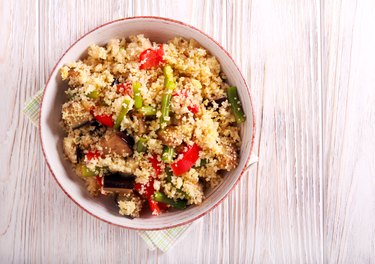
Durum wheat semolina is a type of flour that is often used to make pasta. It is also used to make couscous. Cooking pearl couscous is much different from cooking pasta, however.
Like pasta, there are different types of couscous. North African couscous is a popular variation, though another common type includes pearl couscous — aka Israeli couscous. Traditional Israeli couscous recipes often include pearl couscous, olive oil, pistachios and dried fruit. With the right techniques, cooking pearl couscous is simple.
Video of the Day
Video of the Day
Israeli Couscous Nutrition Facts
Pearl or Israeli couscous is not the same as regular couscous. The main differences are that Israeli couscous is toasted whereas regular couscous is steamed, and it has a different shape. They also taste differently and even have different nutrition content.
In terms of ingredients, regular couscous is similar to the composition and shape of orzo pasta. However, Israeli couscous starts with a flour dough that is then machine-extracted into tiny pearl shapes. Since Israeli couscous is toasted, it yields a more nutty flavor than regular couscous.
According to the USDA, these are the pearl or Israeli couscous nutrition facts per one serving, which is approximately 1/3 cup before cooking:
- 190 calories
- 6 grams of protein
- 40 grams of carbohydrates
- 1 gram of fat
- 4 percent daily value of iron
- 0 mg of sodium
Since couscous is made from semolina wheat flour, couscous is not gluten-free. It is an excellent source of carbohydrate, but may need to be limited for those following a low-carb diet. Some pearl couscous recipes are made with eggs or chicken stock, so not all traditional Israeli couscous recipes are vegan-friendly.
Read more: What Are the Health Benefits of Couscous?
Cooking Pearl Couscous
Traditional Israeli couscous recipes may sound intimidating, but they are beginner-friendly. Though you can purchase boxed or frozen couscous that is pre-cooked or can be heated in the microwave, traditional Israeli couscous recipes are made on the stove top with a skillet.
To make Israeli-style couscous, start with dry pearl couscous. You can purchase this at the grocery store next to the grains or in the specialty food section. Like grains, dried couscous increases in volume as it cooks. One cup of dried couscous will make approximately 2 to 3 cups once cooked.
Things You'll Need
1 cup of dried pearl couscous
2 cups of broth
1-2 tablespoons of olive oil
1/4 cup of pistachios or pine nuts
1/4 cup of chopped onion
1/8 cup of dried fruit, such as dried apricots, raisins or barberries
Herbs and spices, such as parsley and salt
Heat olive oil in a pan over medium-high heat. Saute the nuts until toasted. In a separate skillet, heat more olive oil and add the couscous, onions and broth. Bring to a boil and then reduce to a simmer. Cook the couscous for five to seven minutes. Once tender, remove from heat and add the toasted nuts, dried fruit, herbs and salt. Stir until combined.
Read more: Durum Wheat vs. Whole Wheat
Traditional Israeli Couscous Recipes
Pearl couscous can be used in place of other types of couscous. Mayo Clinic recommends incorporating it into salads with fresh vegetables and spices.
You can also incorporate couscous in place of grains, such as rice or quinoa, and as a side dish. Traditionally, couscous is often served with a meat or stew on top. Per Cleveland Clinic, Mediterranean-style couscous is paired with grape tomatoes, cucumber, lemon and fresh sage.
Whether you are intrigued by the Israeli couscous nutrition facts or delicious recipes, everyone should try couscous. If you are a fan of traditional and alternative pasta recipes, you will likely enjoy couscous recipes.
Was this article helpful?
150 Characters Max
0/150
Thank you for sharing!
Thank you for your feedback!